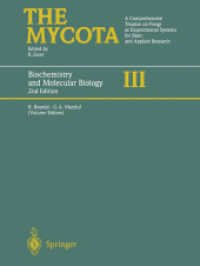Full Description
The linguistics and language education world has recently experienced a rapidly proliferating interest in applying technology. This interdisciplinary area bridges the gap between two previously separate fields.
Innovations and Applications of Technology in Language Education is a collection of 12 chapters by an international group of language and linguistics education experts. Although technology in language education is a global interest, its practices should be contextualized. This book covers how language educational technology is currently applied, discusses how it should be applied, and gives directions for its future development.
Providing a critical review of respective current practices and perspectives, this book begins by presenting a set of research‑based principles for developing second language teachers' professionalism. It then examines the use of technology to enhance students' English language skills. Acknowledging the advantages and disadvantages of AI‑mediated communication, this book argues for the use of AI to facilitate communication in language education. It also proposes the use of AI to develop and administer language tests and suggests guidelines for practitioners to deploy AI in developing and administering language tests efficiently. This book concludes by discussing technology for specific purposes in second language education and the potential of computer‑mediated communication (CMC) to enhance interaction between students.
Contents
Editors. Preface. List of Contributors. Section I TECHNOLOGY-ASSISTED LANGUAGE EDUCATION. 1 Professional Learning for CALL Teachers: A Research-Based Approach. 2 Designing and Implementing WhatsApp Communication Tasks for the English as a Foreign Language Classroom: A Case Study. 3 Evaluation of ELSA Speak Used by Vietnamese University EFL Students. 4 Critical Appraisal of Artificial Intelligence-Mediated Communication in Language Education. 5 "Write It Out!": Using Digital Storytelling (DST) to Positively Engage Pre‑Service EFL Teachers with Digital Content and to Enhance Their Writing Skills. 6 Revitalizing English Language Learning: An Exploration of ChatGPT's Impact on Student Engagement and Motivation. Section II TECHNOLOGY-ASSISTED LANGUAGE TESTING AND ASSESSMENT. 7 Technology‑Based Language Testing: Principles and Future Directions. 8 Technology‑Assisted Task‑Based Second Language Assessment for Learning. 9 The Use of Artificial Intelligence in Language Test Development and Administration: What, How, and Why. Section III USING TECHNOLOGY FOR SPECIFIC PURPOSES IN LANGUAGE EDUCATION. 10 Using Asynchronous Computer‑Mediated Communication to Increase Students' Out‑of‑Class Interaction. 11 Impacts of a Blended Learning Model on EFL Students' Engagement and English Proficiency: Evidence from IELTS Preparation Courses. 12 EFL Teachers' Informal Digital Learning of English and Its Effects on Their Instructional Willingness to Communicate in English. Appendix A: Pre‑Test and Post‑Test Questionnaires. Appendix B: Feedback Questionnaire on ChatGPT.








